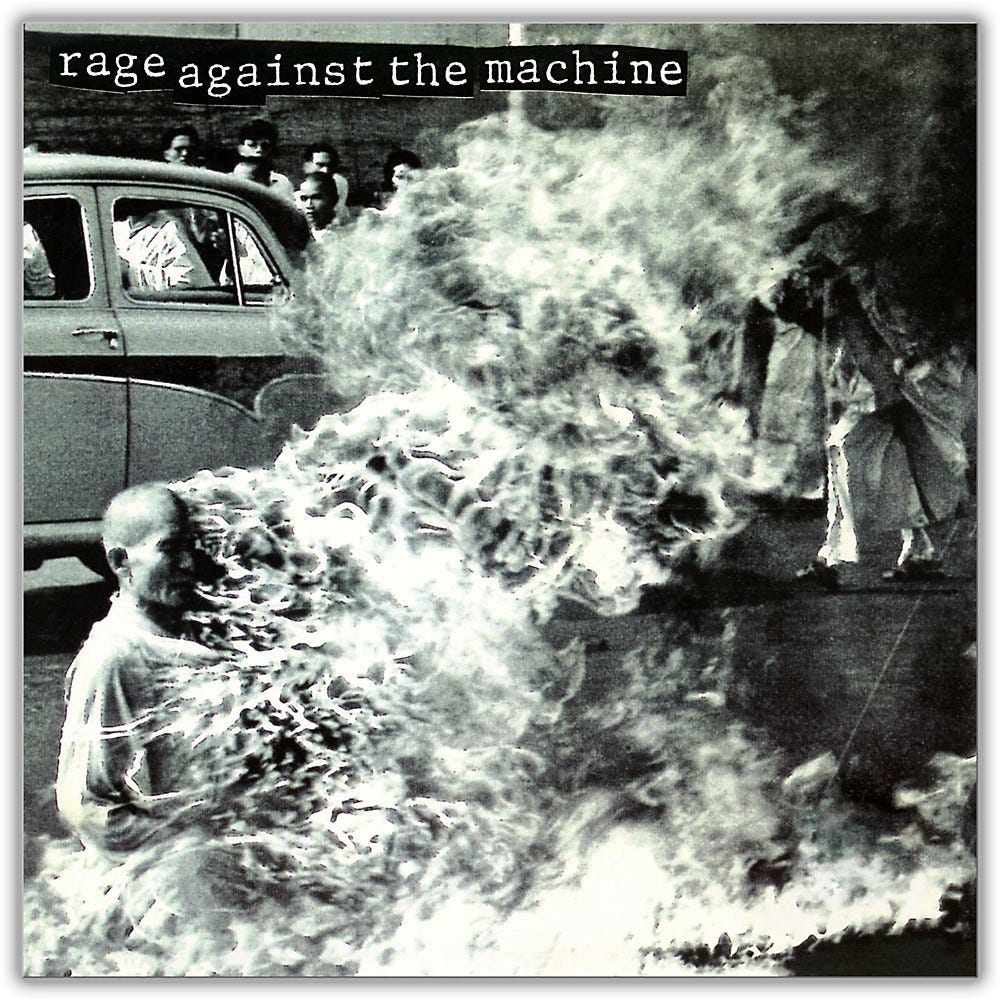In 1992, a band named Rage Against the Machine exploded onto the music scene with their self-titled debut album, a powerful fusion of rock, hip-hop, and incendiary political commentary. The album’s cover is one of the most striking and harrowing images in modern music history: a black-and-white photograph of a Buddhist monk engulfed in flames, sitting in absolute stillness. This is not mere album art—it is a moment in history, an act of profound spiritual and political significance.
The Story Behind the Image
The photograph was taken on June 11, 1963, by Associated Press photographer Malcolm Browne. It captures the self-immolation of Thích Quảng Đức, a Vietnamese Buddhist monk, on a street in Saigon (modern-day Ho Chi Minh City). Thích Quảng Đức’s act was a protest against the persecution of Buddhists by the U.S.-backed South Vietnamese government, led by President Ngô Đình Diệm, a Catholic ruler in a predominantly Buddhist country.
At the time, Buddhist monks and laypeople faced systematic discrimination, including restrictions on religious practice, the destruction of Buddhist temples, and suppression of their voices in the political sphere. In response, Buddhist monks organized demonstrations and hunger strikes. Thích Quảng Đức’s self-immolation was the ultimate act of defiance, meant to bring the world’s attention to their suffering.
His final words, recorded in a letter, read:
"Before closing my eyes and moving towards the vision of the Buddha, I respectfully plead to President Ngô Đình Diệm to take a compassionate heart toward the people and implement religious equality to maintain the strength of the nation eternally."
The Power of Stillness in Flames
What makes this image so unforgettable is not just the horror of a man burning alive, but the absolute serenity with which Thích Quảng Đức endured the flames. Witnesses described how he never flinched, never made a sound, and remained seated in the lotus position as his body was consumed by fire. In Buddhist thought, this level of composure suggests an extraordinary mastery of the mind—an attainment of deep samādhi (meditative absorption) and equanimity.
His self-immolation was not an act of despair or self-harm, but a deliberate offering, a final teaching. It embodies the Mahāyāna Buddhist ideal of the bodhisattva, one who sacrifices themselves for the awakening and liberation of all beings. In Buddhist history, there are precedents for such acts, such as the Jātaka tale of the Bodhisattva who offers his body to a starving tigress to save her and her cubs. Thích Quảng Đức’s action belongs to this lineage of profound compassion.
Rage Against the Machine’s Political Statement
Why did Rage Against the Machine choose this image for their debut album cover? The band is known for their radical leftist stance, anti-corporate views, and opposition to state violence. By using this image, they aligned themselves with a tradition of resistance against oppression.
The album itself is a sonic and lyrical firestorm against systemic injustice—police brutality, government corruption, and capitalist exploitation. Songs like "Killing in the Name" and "Wake Up" call for rebellion against the forces that perpetuate inequality and violence. The band saw Thích Quảng Đức’s act as the ultimate embodiment of defiance against tyranny.
A Buddhist Reflection on Protest and Violence
From a Buddhist perspective, this raises interesting ethical questions. Buddhism generally advocates for nonviolence (ahimsa), yet self-immolation is an extreme act of protest. How do we reconcile this with Buddhist teachings?
One way to approach this is through the lens of upāya (skillful means). Thích Quảng Đức did not harm others—he turned the fire inward, demonstrating that true protest does not require hurting others. His self-immolation forced the world to pay attention. Shortly after his act, international pressure mounted on the South Vietnamese government, and President Diệm was eventually overthrown. In this sense, his sacrifice had a tangible impact.
However, self-immolation is not a practice widely encouraged in Buddhist traditions. Some contemporary Buddhist teachers argue that suffering should not be used as a tool for political change. Others, like Thích Nhất Hạnh, saw Thích Quảng Đức’s act as a powerful message of nonviolent resistance—an act not born from hatred, but from a deep, compassionate wish to relieve suffering.
The Legacy of Thích Quảng Đức and the Album
Rage Against the Machine’s debut album went on to become one of the most influential protest records in history. The image of Thích Quảng Đức remains iconic, a symbol of both spiritual mastery and political resistance.
For Buddhists, this image invites deep contemplation. It asks us: What does it mean to stand against injustice? How far should we go to uphold the Dharma? How do we balance nonviolence with the urgency of action?
Ultimately, the message of Thích Quảng Đức and the album that immortalized his sacrifice is one of awakening—to suffering, to injustice, and to the power of fearless compassion.
What are your thoughts on this album cover and its significance? Do you see Thích Quảng Đức’s self-immolation as a Buddhist teaching, a political act, or both? Let’s discuss in the comments.
If you enjoyed this reflection, consider subscribing to my Substack for more explorations of Buddhism in modern culture.






Thank you Matteo for sharing these thoughts and this ever-disturbing image. Important questions are raised about non-violence and self-sacrifice. No answers here, but they've caused me to reflect, which is enough for right now.